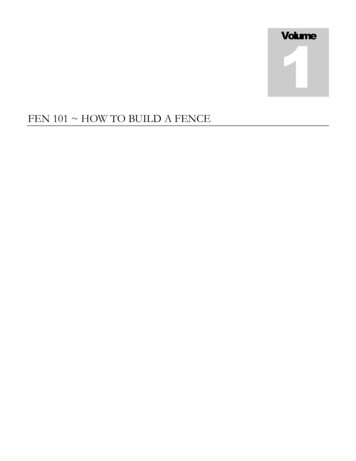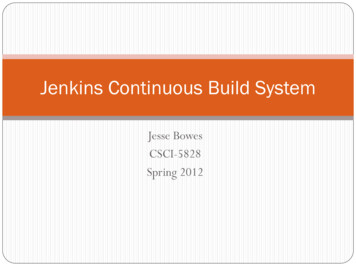
Transcription
Volume1FEN 101 HOW TO BUILD A FENCE
Table of ContentsChapter 1: Do I really need a fence?Chapter 2: Hire a Professional or Do It Yourself JobChapter 3: What Type of Fence Should I Install (Fence Types)Chapter 4: Tools Needed to Get StartedChapter 5: Installing the Fence (The Specs)Chapter 6: Additional Good Books
T H EF L YF I S H I N GT E X T B O O KChapter1Do I really need a fence?First of all, welcome to FEN 101, otherwise known asHow to Build a Fence. You are about to explore thewonderful world of fence building. This how to guide willprovide you with a step by step framework for creating afence. We will look to explore everything from the initialthoughts of building a fence to the end product andmaintenance. Whether you are a novice or expert fencebuilder you are almost guaranteed to learn or familiarizeyourself with something you may not have known previouslyabout fence building. For purposes of this book we willexplore primarily how to build residential fences. Anythingbeyond residential fences (commercial and industrial) requires1
the same basic methods as residential fences but are subjectedto various government rules and regulations. Well, good luckwith the project and happy fence building.The first question you should ask yourself before yougo through with building a fence is, “Do I really need afence?” To answer this question thoroughly you will have toconsider a number of things.The first and foremost reason you may need to build afence is to meet local government (city, town, state) rules andregulations. Many local governments require that certaintypes of commercial industries fence in their businesses. Inaddition, pool and pet owners are often required to fence inthe area around their pool or animal. If this is the case thenit's a given, you are in definite need of a fence in order tomeet these rules and regulations. Trying to evade thegovernment and violate local laws will only lead to troubles2
and liabilities down the road. Taking proactive measures toprevent and secure your parcel from potential liabilities is awise investment that will most likely save your trouble in thelong run.On the other hand, if it is not required by the localgovernment your next question should be can I afford it?Although it may not be required by law to have a fence forthe given parcel, your desire to enclose it may be a matter ofaesthetics. When this is the case you simply need to recognizefinancial concerns. If you can afford it and have discussed theidea with your family then by all means you should go for it.However, if you find yourself in financial trouble and don'treally have any real need for the fence other than to beautifyyour parcel then you may want to reconsider building a fence.3
Chapter2Hire a Professional or Do ityour self.For the most part this book will entail details on the “do ityourself job” of fence building.However, consideringwhether a professional is needed should be a seriousconsideration.You may need to consider hiring aprofessional if you are on a strict timeline or the project isjust too large for you to do yourself in a reasonable amountof time. Nonetheless, getting yourself involved with a fenceproject only to find out a week into you are over your head isa real concern.Now you are probably thinking, “What’s the big deal, ifI start it and realize I’m in over my head then I’ll just hire out,they will pick up where I left off and all will be fine.” Well,4
only the end result of the project being fine is agreeable.Starting a project and deciding that you need to hire out halfway in will often result in a greater financial, time, and laborloss. For example, suppose you decide that you want toinstall about 2000 feet of aluminum fence over the course ofa month with intentions of a having installing a pool by July.In addition, you realize that you are budgeted in order toafford the pool you plan to install in the upcoming months.You go to the local stores, shop around and find the bestmaterials at the most reasonable costs. At the start of thefence project, day 1, you have all the necessary materials andappropriate project outline for the fence. Your drawings callfor one fence post every 6 feet dug approximately 3 feet deepwith crushed stone surrounding the base. You pull out yourpost hole digger and immediately jump into the project. Atthe end of day one you have finished installing 25 fence postsand have spent a little over 8 hours on the project (assuming5
each fence post you installed from digging to backfilling tookonly 20 minutes non-stop.) At the start of day two your backis hurting, hands are blistered, and overall your body just feelsspent. As a result, you take a day off and continue day twoon what would have been day three. After a week passes youhave successfully installed 150 posts (basically setting theground work for 1500 feet of fence) continuing the formatused on day one. Now your week long vacation is up andyour regular job resumes Monday. With only three weeks leftuntil you anticipated on installing your fence you realize atthis rate you will not be able to finish the project simplyworking on the weekends and you can’t afford to take anymore time off from work. As a result you decide to hireprofessionals to get the job done for you.After calling the professionals you are excited to findout that they can install 2000 feet of fence in less than twoweeks. However, in order for the company to warrant there6
fence installation they refuse to use the materials you boughtand will only install fence fabric on posts the company hasinstalled. Now you are out a week’s vacation, hundreds ofdollars in supplies, and countless hours spent attempting todo it yourself.In addition, you now have to pay theprofessionals for their labor and materials.Essentially, this may never actually end up happening.However, the point is to be aware that many companies willnot accept labor or materials purchased from other vendorsincluding yourself. The professionals often carry warrantieswith their fence installations and will not assume the liabilityinvolved with continuing work that is not originally theirown.7
Chapter3Fence TypesBefore deciding on what type of fence to install youmust consider a number of different factors. Are you in needof privacy? Do you need a place for your dog to run freewithout getting into trouble or danger? Are your childrenable to play in a safe place without you worrying aboutstrangers or traffic? If you own a pool, have you metgovernment regulation and more importantly limited yourpotential liability? Or, maybe you feel your yard needs a littlesomething extra to give it an architectural edge. Nonetheless,this section of the book will help you determine which typeof fence is right for you.8
The initial step is to decide whether the fence is to befor a swimming pool or other miscellaneous residentialpurposes. The following are possible reasons for needing toerect a residential fence assuming appearance is the mostimportant attribute:Aesthetic Landscaping:Vinyl Classic Picket - Straight TopAesthetic Landscaping (cost effective):Residential Aluminum Delgard Avalon StylePrivacy:Vinyl Tongue & Groove Privacywith Closed Spindle9
Privacy (cost effective):Residential Chain Link (Galvanized) with SlatsContain Animals or Small Children (cost effective):Residential Galvanized Chain LinkIdentify Property Boundaries:Vinyl Contemporary Picket - Straight TopIdentify Property Boundaries (cost effective):Ranch RailProtect Property from Animalsand Unwanted Guests:Commercial Delgard Madrid Style10
Protect Property from AnimalsAnd Unwanted Guests (cost effective):Residential Galvanized Chain LinkRestrict Access to Unwanted Strangers:Commercial Delgard Madrid StyleRestrict Access to Unwanted Strangers (cost effective):Residential Galvanized Chain Link11
Chapter4ToolsThis section will outline the tools and materials needed inorder to carry out your fencing project. A wide array of toolsmay be used in order to get the job the done to fit anybudget. The following is a list of tools and materials neededin order to construct a fence:All FencesCostlier but More Efficient:Power SawMachine Post Hole DiggerSteel Tape MeasureMarking PencilHammerWork GlovesUltra Laser LevelReady Mix ConcreteTamping RodWooden Stakes & Nylon LineCheaper but Less Efficient:Jig Saw or HacksawMechanical Post Hole DiggerPlastic Fabric Tape MeasureMarking PencilHammerWork GlovesStandard LevelGravel, Crushed Stone, or SandTamping RodWooden Stakes & Thin Rope12
Now depending on the exact type of fence you arelooking to construct you will fine the specific materials willvary from project to project. Wooden fences will requirewooden posts and boards in addition to a nails, wood chisel,preservative, paint, and stain. Aluminum fence will requirealuminum posts, aluminum fabric, wire ties, aluminum postcaps, and wire cutters.Many steel and vinyl fences are likely to come preassembled for the most part and will only require you to digand set the fence posts. In addition, you will need to properlyconnect each segment of the fence together. Many of thesefences comes with small tags with specific instructions onhow exactly the fence should be connected.One other “tool” you may need is a building permit.Make sure to check with your town clerk to verify the needfor a permit. Also, be aware of any state or local codes to13
that may apply to your project. Violating any laws and statueswill almost guarantee you unnecessary headaches down theroad. Lastly, be sure to follow all safety precautions andwarnings associated with the type of fence that you areinstalling.Once you have determined the height you would like orare required to build your fence you will need to purchasematerials. The following is a general guide to determining theamount of material needed for each type of fence:WoodPickets/Fabric 6’Posts8-9’Pickets/Fabric 10’Posts12 – 13’AluminumVinyl6’6’Pre-Assembled to Pre-AssembledPoststo Posts10’10’Pre-Assembled to Pre-Assembled toPostsPosts14
Chapter5Installing the FenceThis is the most important part of the entire book.Properly installing your fence will make all the difference inthe end. Rushing any portion of the project could lead tounwanted effects down the road. For purposes of simplicitythis section is broken up step by step with applicability foreach type of fence.Step 1: Laying Out the Fence LineDecide exactly where youwant your fence to beplaced.shouldWooden stakesbeplaced15
approximately where you would like the fence posts to bedug, however, at this stage it not required. Run string alongthe outside of the proposed fence attaching it to each stakeyou have placed into the ground. To ensure near perfectright angle corners you should use the pythagorean methodfor fencing. Measure six feet away from the corner in onedirection and eight feet in the other direction.Take thesquare root of the sum of each number squared together toget a value of ten feet ( (6’2 8’2) 10’.) Creating a 6, 8, 10triangle will guarantee that right angles are formed at everycorner.Step 2: Treating PostsThis step primarily relates towooden fences.Aluminum and vinyl fences do not warp or rot in the samefashion as wooden fences do. Vinyl fences are made fromplastics and do not rust or rot. Aluminum fences tend to be16
made from aluminum and steel. Aluminum by itself does notoxidize and rust. Steel on the other hand will over time. As aresult, these types of fences come galvanized to protectagainst rusting.If constructing a wooden fence, pressure treated fenceposts should purchased.If this is not an option thenpurchase the appropriate lumber and then coat the wood withthe proper water sealant. Avoiding this step could lead to avery short life span of your fence. Wood that is left untreatedwill rot and warp over time creating a very unsightly and weakfence.Step 3: Proper Post SpacingFor aluminum and wood fences a general rule of thumb isnot to exceed 10 feet between fence posts. Overtime, woodfences that have excessive gaps between fence posts will endup sagging and turn into an unsightly mess.17When
approaching corners the same fence post spacing should beused. However, you may shorten the distance if desired forbetter appearance.In addition to creating proper postspacing, make sure to factor in room for gates. The averageman gate is about 4 feet wide. The size of the gates is entirelyup to the builder.Digging the Posts:To properly dig fence posts you must consider the threedifference kinds of fence posts: line posts, gate posts, andcorner posts. Line posts are subjected to less stress than bothgate and corners posts. As a result line posts holes need notbe dug as wide as gate or corner posts.Generally, about one third of the fence post should bebelow ground. In addition, you should dig approximately 6inches deeper than necessary to leave room for gravel fill atthe base of the posts. This will create the strongest fence18
posts with minimal settling and shifting. The diameter of theline fence posts should range anywhere from 3 to 6 inchesbeyond the diameter of the posts. Obviously the larger indiameter, the more support the post will have. For smallwood fence projects anything more than 3 inches for linefence posts is not required. On the other hand, gate andcorner posts should be more around 6’ beyond the diameterof the fence post to provide additional support for stress.Aluminum fence posts are often subjected to more weightand may need extra support at the base for each line fencepost.Step 5: Setting the PostsThe fence posts should be set on top of approximately 6inches of gravel and surrounds entirely by ready-mixconcrete. Ensuring the post is below front line will helpprevent against frost heaving.19All fence posts should be
centered in the post holes dug. The use of a plumb line orlevel will be necessary in order to ensure is vertical whilefilling in the hole. To add ex
For purposes of this book we will explore primarily how to build residential fences. Anything beyond residential fences (commercial and industrial) requires 1Chapter. 2222 the same basic methods as residential fences but are subjected to various government rules and regulations. Well, good luck with the project and happy fence building. The first question you should ask yourself before you go .











